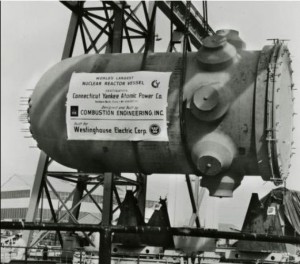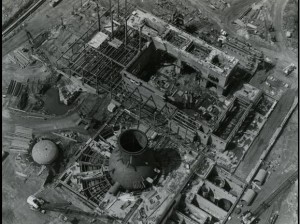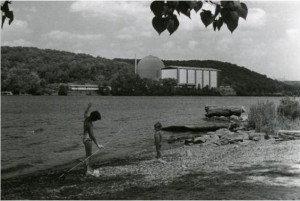By Ben Gammell

World’s Largest Nuclear Reactor Vessel. Photograph, 1966. Connecticut Yankee’s nuclear reactor vessel is shown being loaded onto a barge in Chattanooga, Tennessee to be transported to Haddam Neck – Connecticut Historical Society
Connecticut Yankee Atomic Power Company, Connecticut’s first nuclear power plant, began commercial operation, in Haddam Neck, on January 1, 1968. It was a time of high expectations for the economic potential of peaceful nuclear energy. An enthusiastic 1962 article in the Hartford Courant, titled “Atoms Now Power Homes,” predicted that nuclear power would soon compete with coal and oil. New England’s first station, Yankee Rowe, had begun operation in Massachusetts in 1961. Then came Connecticut Yankee, followed by Millstone in Waterford, Connecticut, in 1970, and Maine Yankee in 1972. In 1963 the president of Connecticut Light & Power, the lead investor in Connecticut Yankee, mused, “It may be that nuclear fuels will be used in all new power plants built in the region in the years ahead.”

Millstone Point Company, Waterford. Photograph by Kevin Donovan Films, 1967. The plant is shown under construction – Connecticut Historical Society
As a competitor with coal, oil, and other fossil fuels, nuclear power in the United States has had mixed success since the 1960s. While Connecticut Yankee operated for nearly 29 years, generating over 110 billion kilowatt hours of electricity, high operational costs led to its closing in 1996. Maine Yankee also closed in 1996; Yankee Rowe closed in 1992. Low oil and natural gas prices; increased safety regulation; periodic plant shutdowns; and public concern about the dangers of radiation leaks and waste were important factors. Connecticut Yankee was decommissioned, a process that included dismantling the plant and constructing a facility for the long-term storage of spent nuclear fuel and high-level radioactive waste. This project was completed in 2007. The five-acre storage facility is all that remains on the Connecticut Yankee site.

View of Connecticut Yankee Atomic Power Company, Haddam Neck. Photograph, ca. 1968 – Connecticut Historical Society
The Nuclear Waste Policy Act of 1982 requires the US government to build and operate a national storage facility for spent nuclear fuel and high-level radioactive waste. Until this occurs, Connecticut state law prohibits the construction of additional nuclear power stations in the state. However, two reactors at the Millstone Power Station, added to the plant in 1975 and 1986, continue to operate, generating nearly 50% of the electricity produced in Connecticut today. Spent nuclear fuel and waste continue to be stored onsite until a national storage facility is built. Millstone Power Station’s first nuclear reactor was closed in 1998 and is currently being decommissioned. For many today, as in 1968, expectations for nuclear energy remain high yet its future remains uncertain.
Ben Gammell is Coordinator of Interpretive and Education Projects at the Connecticut Historical Society.
© Connecticut Public Broadcasting Network and Connecticut Historical Society. All rights reserved. This article originally appeared on Connecticut History | WNPR News
Note: ConnecticutHistory.org does not edit content originally published on another platform and therefore does not update any instances of outdated content or language.









